Progressive lenses are a perfect choice for anyone that wants to improve their vision with glasses but needs correction for both nearsighted and farsightedness. This is an issue that’s common for many people, especially as our eyes age.
So, how do you know when to get progressive lenses? If you’re already wearing glasses or contacts for farsightedness, but you’re noticing that it’s becoming increasingly difficult to see things up close, too, then progressive lenses can help.
If you’re wondering whether or not you’re a candidate for progressive lenses, this article is for you. Or, if you know you need progressive lenses, but you’re picturing some unsightly glasses, then this article is for you, too. Keep reading; we’ve got all things related to progressive lenses, right here. And, when we’re done, you’ll be able to decide whether or not you’re ready for a pair.

What are Progressive Lenses
Before we get into the decision-making process, let’s first discuss what exactly progressive lenses are. Part of getting older means changes in how we see, more specifically, worsening eyesight. This is known as presbyopia. Aging eyes become more and more likely to experience difficulty in seeing up close, or, become more farsighted.
Some people can remedy their new farsightedness with a pair of readers, or glasses that magnify small print. However, there are plenty of people who are already wearing corrective eyewear for nearsightedness, so correcting the problem means adding another pair of glasses to the mix.
Enter progressive lenses. Instead of carrying around multiple pairs of glasses, these lenses are customized to fix the problem. But, unlike traditional lenses like bifocals or trifocals that have a line, letting everyone know that you’re wearing multifocal lenses, progressive lenses have no line.
How do They Work?
Progressive lenses are meant to correct vision that’s slowly worsening with age, in three separate sections. There’s a top, middle, and bottom. And, unlike regular multifocal lenses, there’s no harsh line that forces your eyes to jump between prescriptions abruptly. The transition with progressive lenses is smooth and gradual.
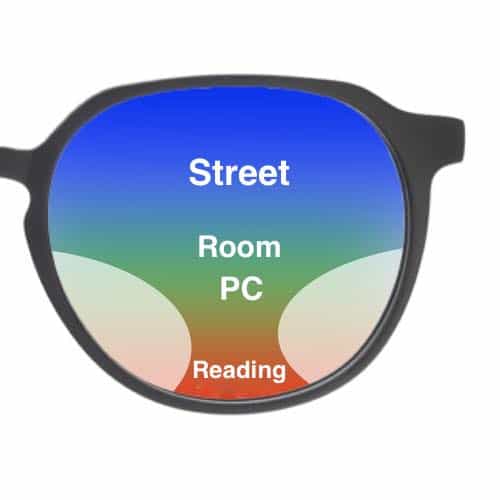
Upper Section
The top third of progressive lenses is adjusted to fit the prescription strength for better seeing things that are far away.
Middle Section
Right in the center of the lens is the area that aids in middle, or intermediate distances. An intermediate distance would be considered right around arms’ length.
Lower Section
The bottom, lower part of the lens, is dedicated to seeing up close. If you’re usually using readers, this section of the lens eliminates the need for that additional pair of glasses.
How to Use Progressive Lenses
The idea behind progressive lenses is simple yet brilliant. As we know, instead of three pairs of glasses, with progressive lenses, you’ll just need one. Progressive lenses are quite. Literally, three pairs of glasses all rolled into one.
To use the lenses correctly, you’ll just need to access the part of the lens, depending on where you’re looking. If you’re struggling to see far away, then you’ll need to look through the top part of the lens, and your eyes will adjust to see more clearly in the distance.

If your vision is blurred when attempting to focus on something up close, then looking down, through the lower section of the lens, will fix that problem. And, naturally, the middle part of the lens is for seeing things that aren’t too far away or too close. It helps you see things more clearly that are right in the middle.
Although it might seem like the eye movement and using different parts of the lens might take some getting used to, they’re designed to work with the natural position of your eyes while you see at different distances.
When you’re looking at something up close, or when you’re reading, it’s pretty much right under your nose. So, your eyes will look down, and this is exactly where the section of the lens is placed for clarifying things that are up close.
The same goes for distances. Imagine trying to see something far away and how your head and eye move. There’s usually a fair amount of squinting and trying to look up, so that’s why the top part of the lens is positioned.
How to Tell if You Need Progressive Lenses
Progressive lenses can make life easier. However, they’re not right for everyone. If you’re unsure about whether or not you can benefit from progressive lenses, ask yourself the following questions. The answers will help you determine if progressive lenses are an option.
Are You 35-40 Years Old?
Age is most definitely not the only determining factor in whether or not you should choose progressive lenses, but it’s a good starting point. Some children can benefit from progressive lenses, but the majority of those that will benefit from progressive lenses are at least 35 to 40 years old.

Between the ages of 35 and 40, we start to see vision changes, and unless you’re aging backward, the changes aren’t positive ones. This is the age when vision begins to worsen, especially seeing things up close. Again, this condition is known as presbyopia.
So, if the answer to this question is yes, then progressive lenses might be an option for you. But, keep reading to help you make the final decision.
Are You Wearing Multiple Types of Corrective Eyewear?
Owning a pair of progressive lenses reduces your need to carry around more than one type of corrective eyewear, but this is only a struggle for those of us that need more than one type of correction.
Or you just don’t want to look for your reading glasses. Then your progressive lenses would give you the clear image while reading although you have no prescription in the upper part of the lenses.
Do Your Current Multifocal Lenses Make You Feel Older?
Let’s face it, traditional multifocal, or trifocal, lenses aren’t the most stylish. And, the lines across the lenses that designate the different focal areas are basically just a sign that says, “over 40 right here”.
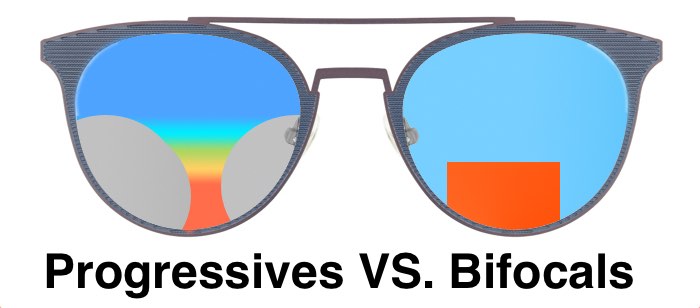
Progressive lenses conceal the different areas of focus, so unless someone is really looking, it’s almost impossible to know that they’re anything other than just regular, trendy glasses.
Speaking of trendy… progressive lenses are also available in up to date, in style frames. Other types of multifocal glasses haven’t quite caught up in style years as of yet. Usually you will not find a bifocal lens segment is very curved lens designs for example.
But for more information about progressives vs. bifocals read this blog post here.
Do You Feel Like Your Current Multifocal Lenses Need a Prescription Upgrade?
It’s important to see an eye doctor every year because aging eyes do continue to decline, so prescriptions should be adjusted accordingly. If you feel like the lenses you’re currently wearing are in need of a prescription adjustment, then a move to progressive lenses could be in your near future.
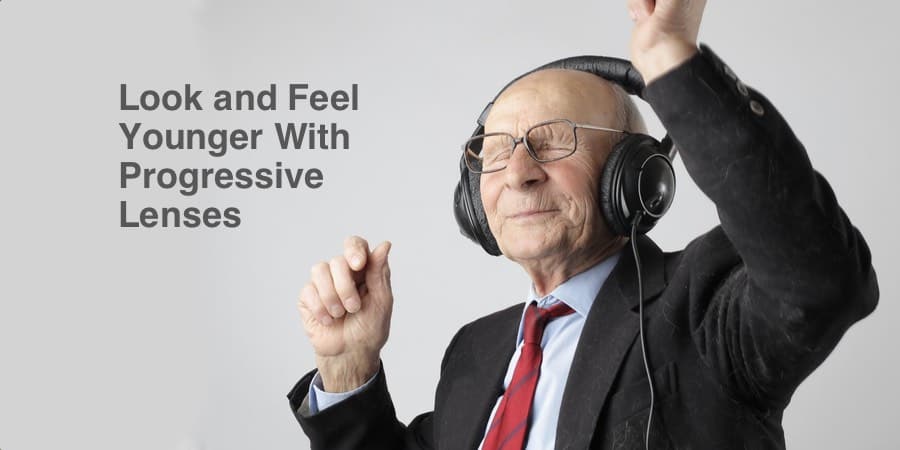
Another indicator that progressive lenses could be beneficial is discomfort when using your current prescription lenses. Dizziness or difficulty with adjusting vision can also be a sign that your prescription is in need of adjustment.
Do You Work at a Computer Frequently?
Almost anyone that spends a lot of time in front of a computer screen is going to experience some related vision issues. Progressive lenses can sometimes provide a solution, by making those things at intermediate distances more clear. But, if the problem is solely from computer screen time, then it’s a pair of special progressive lenses that are ideal, with a higher prescription strength in the central part of the lens.
Just look at the picture below. Here you can see two types of progressive lenses. On the left a normal progressive lens of everyday use is shown. on the right an office lens or computer lens is shown. If you are not sure if your progressive lenses are right for your computer work read this article here.
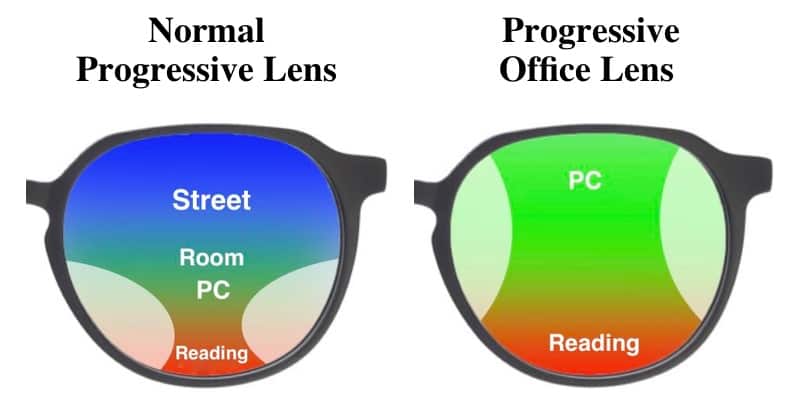
Pros and Cons of Progressive Lenses
Another way to help you decide whether or not you need progressive lenses is determining if the pros outweigh the cons for you. This information can be pertinent in guiding your decision on when to get progressive lenses.
Pros
Let’s start with the positives first and identify the reasons why progressive lenses are so great.
Less to Carry
As we’ve established, progressive lenses reduce the number of things you’ll need to carry with you, by eliminating the need for additional corrective eyewear. This also means you’ll have one less thing to lose, and if you’re like me, that’s a huge bonus.
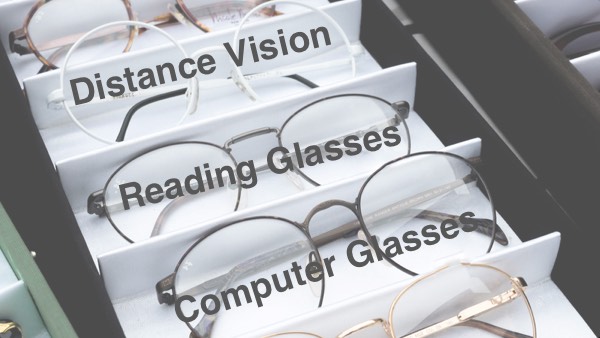
No Image Jump
With traditional multifocal lenses, the line that establishes the different prescriptions can create a barrier between your eyes and the objects. As you can imagine, this can be a potentially dangerous situation in some cases. But, with progressive images eliminating the lines, they also get rid of the risk that comes with them.
They’re More Stylish
We’ve touched on the fact that progressive lenses are definitely a more stylish alternative to their other multi-lens counterparts. So, if appearance is important, and you’re not wanting to let everyone know that you’re wearing multifocal lenses, then this is a definite pro.
Astigmatism Correction
That’s right; progressive lenses aren’t only meant to fix the challenge of seeing up close and far away. They can also help to correct astigmatism.
Astigmatisms cause a point to not properly appear on the retina. The result is blurry vision. Progressive lenses are able to remedy the blurred vision aspect.
Cons
Let’s focus on the other side of things, for just a minute. And examine the cons. Knowing all of the angles will just help you make a better decision in the long run.
You Have to Learn a New Skill
Looking through the different areas of the lens is designed to be more streamlined and simple, as we already know. But, that doesn’t mean that doing this won’t take some getting used to.

There will be a period when first introducing your eyes to the progressive lenses when things will take a little getting used to.
Higher Price Point
Progressive lenses are a much more customized piece of equipment. Depending on the type you get, they can be expensive. There’s quite a variety of price tags that come with progressive lenses, so more than likely. There’s a pair that will fit into your budget. But you’ll need to plan on spending more than you would on traditional lenses.
Significant Trial and Error Period
The only way to make sure that progressive lenses are the right solution for you is to just try them out. And give them a fair chance to work. There’s an adjustment period for anyone that wants to wear progressive lenses.
Wearing them for at least a couple of weeks is necessary to ensure that you’re allowing your eyes a chance to get used to the lenses and actually see if they’ll work.
What to Expect with Progressive Lenses
Before you commit to going to the eye doctor and getting progressive lenses, knowing what to expect can help you decide if they’re right for you. As we mentioned, giving the lenses some transition time is important, so preparing yourself for what’s ahead will help in the long run.

Depending on your age buying your progressive lenses you will get a different experience. If you want more information on how wide your clear field of view will be visit our in-depth article here.
At the Eye Doctor
The only way to ensure that your progressive lenses are going to fit correctly, and to maximize the efficiency of the lenses, a visit with the eye doctor is a must. There are plenty of eye doctors that specialize in progressive lenses.
Before you book your appointment, double-check to make sure that those are offered through the eye doctor you choose.
Q & A Period
Your doctor will ask you questions about your lifestyle, so he or she can pinpoint exactly what you’ll be wearing your glasses for. This will also help in choosing a style of frame that’s conducive to your day to day activities.
Eye Exam
Of course, there will also be an eye exam. The doctor will check each eye during the in-depth exam and how well your eyes play together. Both eyes can have different prescriptions, so this part is really important in identifying the strength needed in each eye.
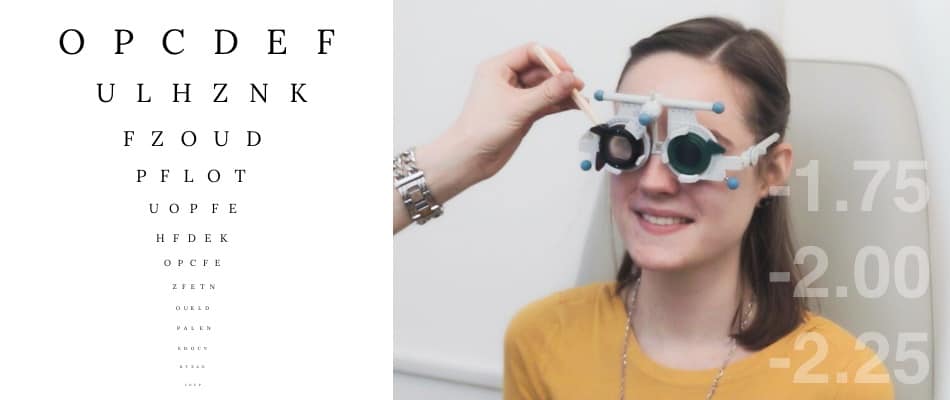
Don’t worry. This doesn’t hurt; it’s actually really kind of relaxing. You just read letters and numbers, all while the doctor tests different strengths in lenses.
Measurements
Before you leave, you’ll have your measurements taken to be properly fitted for a pair of frames. It’s worth noting that when choosing a style, bigger frames work best with progressive lenses. This provides more space for all three prescriptions within the lens.
The distance between your pupils is one measurement; this is known as pupilatory distance or PD. They’ll also as well as the width of your head.
There are many websites that tell you how to measure these on your own, but it’s very, very important to make sure these are done correctly, with the proper tools.
The smallest error in sizing can make a big difference in the way the glasses fit, making them too tight or too loose. And, even worse, ill-fitting frames or a miscalculated pupilatory distance can create even more issues with your vision. And that basically negates the whole idea of getting progressive lenses.
Additional Components
To make sure that you’re getting the most out of your new progressive lenses and depending on the answers to the lifestyle questions you gave your optician, they might suggest some other elements that will enhance your progressive lenses.
Anti-Reflective Coating
This is something that can really make or break the functionality of the lenses. Also known as anti-glare coating, the name is pretty indicative of what it does. A special coating is built into the lenses when they’re manufactured, cutting down on any glare or reflection that might come through while wearing the lenses.
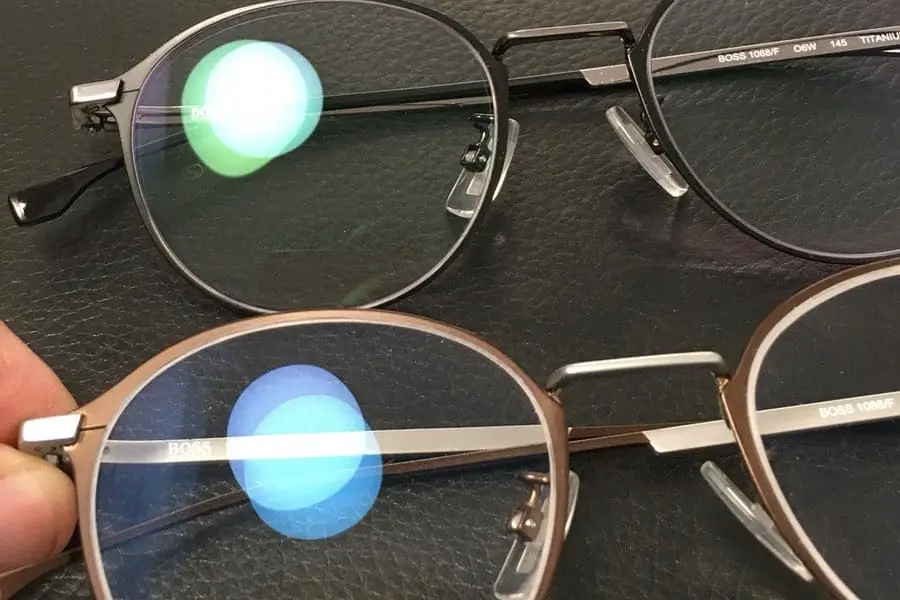
If you’re curious about whether or not this option is right for you, ask your eye doctor. Many of them will have a sample pair of glasses that you can try on, both with and without AR coating. They’ll have you try the glasses on in a few different settings and types of lighting within the office to help you judge the difference and decide if you need this.
Light Adaptive Lenses
Some lenses can actually adjust and provide sun protection, depending on the amount of light that you’re exposed to. If you’re in full sun, the lenses will darken. If it’s partially sunny out, then they’ll be slightly tinted.
Another name for this type of lens is transition lenses. If one of your overall goals in getting progressive lenses is to avoid carrying around multiple things, this is a great addition. Also, if you don’t want to purchase prescription sunglasses, built-in light adaption is a huge benefit and can save you money in the long run.
Free Form Lenses
This is another option that you’ll be able to choose from. Freeform lenses are created through the most recent and advanced progressive lens technology. Progressive lenses that are made through this manufacturing process have reduced variations and provide what some wearers call “high definition vision.”

This new technology and manufacturing process do come with a price, however. But, most would agree that when it comes to having the best vision that you can, a splurge here and there is worth it.
When You Get Your New Lenses
Depending on what brand and type of progressive lenses you choose, and your eye doctor, your new glasses will be ready between one to three weeks after they’re ordered. In some cases, they’ll be shipped directly to your home. Other times, they’ll be delivered to the doctors’ office.
Follow Up Appointment
Some doctors will ask you to come in with your new glasses for a follow-up. Or, they’ll have you try them on when you pick them up. They’ll test the fit and make adjustments if they’re too tight or loose.
Also, your vision will be tested again to make sure the prescription is correct. If there are any adjustments that need to be made, now is the time to do it. It might mean the glasses need to go back to the manufacturer, but waiting now is better to make sure they’re able to function in the long run.
You’ll also be given some maintenance directions, as well as cleaning instructions. Most eye doctors’ offices will provide a physical list, and the materials you’ll need to keep your new lenses in the best shape.
This is imperative for the longevity of your lenses. After all, you more than likely paid a pretty penny for them, so make sure they’re in tip-top shape for maximum. With most progressive lenses, the manufacturer has a specific time period that you can make adjustments with little to no cost.
Trial Run
In most cases, just a couple of weeks is a sufficient amount of time to allow your eyes to get used to their new glasses. But don’t get discouraged if it takes a little bit longer. Sometimes, almost a month is necessary. Here are some important things to keep in mind while you’re giving your progressive lenses a chance.
Work Up to Wearing them Often
Taking the glasses off and on forces your eyes to readjust each time. Instead, keeping them on, per your doctor’s recommendations, will lessen the stress on your eyes. Some doctors might suggest starting with a little less time, while others might ask that you wear them for longer.
Start with putting them on before you do anything else in the morning. Then, just wear them for an hour. Add on a little time each day, until you feel like you’re ready to start using them for a more extended period of time.
Just remember to take them off before you fall asleep, wearing them while you’re laying down can bend or misshape your frames. Nothing feels worse than waking up to find your glasses smashed against your face, especially when you spent a lot of money on them. And, it can be a bit of a pain to go back to the eye doctors’ office to have them tightened or readjusted.
Headaches & Dizziness
Be mindful of any physical changes that you experience while wearing your progressive lenses. Some dizziness or a headache here and there is normal with new glasses of any kind, but this is especially true with progressive lenses.
Looking through different parts of the lenses is an adjustment that can be hard and can cause a certain amount of strain on your eyes. This can, and often does, cause headaches. So, this can be just a natural reaction to the new lenses.
Note when you’re experiencing any of these symptoms. This could be an indicator of ill-fitting frames or an incorrect prescription. But, again, this can also just be part of the adjustment process. Just be sure to let the optician know, so that’s its documented just in case it does become an issue.
Balance
If you try on your new progressive lenses and you’re tripping over things, or slightly off-balance, even a little bit, be sure to share this with your optician. Being off-balance can be another indicator of the wrong PD or even an incorrect prescription.
Again, being a little off balance is normal and should go away as you get used to your new progressive lenses. But, if it doesn’t decrease over the trial period, or gets worse, be sure to speak directly with your eye doctor.
Nausea
Don’t be too nervous if you experience a little bit of nausea within the first few days of wearing your progressive lenses. This isn’t usually a direct result of the progressive lenses themselves, but rather a side effect of the dizziness, being off-balance, and even the new head movement.

Head Movement
In the beginning, when you first wear your progressive lenses, you’ll still be in the habit of moving your head to adjust your eyesight. As you wear them more and more, it will become easier to access the different prescriptions within your lenses without moving your entire head.
Rearranging Items
Now that you have new progressive lenses that will help you see better, there are some things you’ll want to move in order to see them better.
Computer Screens
If you’re used to using a computer screen without progressive lenses or using a desk, you’ll want to make necessary adjustments with your new glasses on. In most cases, moving the screen to below eye level will give you the best view, without causing eye strain.
Desks & Chairs
Both of these are typically adjusted to work together. Depending on what you use your desk for, whether it’s using a computer or writing, you’ll want to adjust the chair accordingly, while wearing your new lenses. This will help you easily access the lower part of the lens, without continuously having to move your furniture or adjust.
The Verdict
You’ve successfully done your research, so now you can make the decision… when to get progressive lenses. If you answered the questions above and weighed the positives and the negatives, then determined that you’re ready for a pair of progressive lenses, then you can take the next step.
Now you can start to look for an optician near you and schedule your appointment. Hopefully, with the information we’ve shared, you’ll be able to use those progressive lenses to see better in no time.
